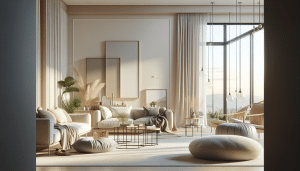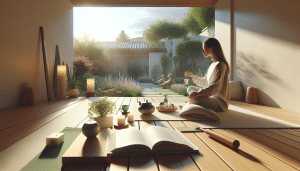You Can Refresh Your Living Space with Sustainable Decor
Jessica White September 20, 2025
Looking to transform your home without harming the planet? Explore how sustainable home decor brings eco-friendly style, personal flair, and ethical choices into every room. This guide shows ways you can create a stunning living space using innovative, responsible, and high-impact design decisions.
Why Sustainable Decor Matters for Your Home
Many consumers wonder why switching to sustainable home decor is considered so important. The impact stretches far beyond aesthetic preferences. When materials are ethically sourced and responsibly produced, the footprint left on the environment is reduced. From bamboo furniture to upcycled lighting, these options help lower waste in landfills and cut down on energy-intensive manufacturing. As people grow more conscious of environmental impacts, the appeal of eco-forward interiors continues to rise. Conscious decorating choices, such as recycled glass vases or reclaimed wood shelves, bridge style and sustainability for a future-friendly home. The appeal of eco homes keeps expanding, and popular interior design magazines now feature innovative solutions that save resources and encourage mindful consumption.
Sustainable décor isn’t just about materials—it’s also about ethical production. Brands increasingly prioritize fair wages, safe working conditions, and community investments. When choosing a sustainable rug or throw pillow, shoppers are often supporting artisans and small businesses, boosting local economies in the process. Such actions foster a sense of global responsibility. They also ensure that the beautiful items found in your living rooms are crafted under humane conditions, adding both beauty and ethical value to the home. The movement toward ethical living is more than a trend; it reflects changing social values and a new era of conscious shopping.
The positive ripple effects of sustainable home decor always extend beyond individual households. By selecting items with smaller carbon footprints or supporting furniture certified by environmental organizations, individuals help nudge the entire marketplace towards improved practices. Over time, the popularity of these choices leads major brands to adopt greener production methods. The demand for eco-friendly home innovation influences supply chains and manufacturing, proving that one home’s decor decisions can inspire broader change.
Eco-Friendly Materials Transform Interior Design
The selection of eco-friendly materials is growing. Options such as natural fibers, recycled metals, and low-VOC finishes have never been more diverse. Organic cotton bedding, for example, brings comfort with a clear conscience, while lamps made from repurposed industrial materials add unique flair and lower environmental impact. Even wallpaper comes in non-toxic, biodegradable forms now. The push for green materials reshapes design from the ground up. Homeowners find joy and pride in seeking linens or cushions featuring the Global Organic Textile Standard (GOTS) label, knowing their choices support clean production standards.
Natural materials such as jute, cork, or rattan create organic warmth and tactile interest. Cork floors resist mold and mildew, making them ideal for allergy-sensitive families. Bamboo, rapidly renewable and striking, finds its place in everything from headboards to utensils. Many designers emphasize the emotional connection created by bringing earth-friendly elements into the home, offering calming and restorative atmospheres. It’s not just about the environment—it’s about cultivating well-being in every room. Using locally sourced woods and handmade ceramic planters, interior spaces feel richer and more grounded.
Manufacturers have also innovated new uses for previously discarded materials. Recycled plastics, once seen as waste, now become sleek chairs or durable outdoor rugs. Even ocean plastics find second lives as beautiful decor pieces. These inventive approaches divert tons of waste from landfills and oceans. Carefully curated collections featuring upcycled components prove that sustainability and great looks are not mutually exclusive. By blending these materials into modern interiors, sustainable design earns its place alongside classic favorites.
How to Create a Personalized Eco Chic Space
Personalizing a sustainable living space begins with small, intentional choices. Select accent pieces or colors that resonate emotionally—maybe a soft pastel wall with repurposed artwork or vintage mirrors that bring both nostalgia and conservation. Plants are an essential element, cleaning indoor air and adding a living, breathing flair. Hanging a few air-purifying ferns or succulents by sunny windows infuses freshness and brings the outdoors inside. These decisions transform a standard room into a unique expression of values and creativity. “Eco chic” isn’t about minimalism alone—it’s about infusing character and meaning into sustainable designs.
Tactile layering is key. Mix upcycled materials, like a salvaged wood coffee table with handwoven organic throws, and watch how textures come alive. Thrift shops and flea markets are playgrounds for sourcing one-of-a-kind pieces. Secondhand shopping not only reduces waste but uncovers treasures with history and charm. Personalized combinations of these finds build visual interest while honoring eco-friendly principles. Accessories like repurposed glass bottles as vases or reclaimed baskets for storage add quirky, functional touches that spark conversation and comfort alike.
Lighting can transform the personality of a room. Choose LED bulbs or solar-powered lamps, framed by reclaimed driftwood or antique fixtures. Energy-efficient choices reduce bills and your carbon imprint without sacrificing style. Even paint choices matter: opt for brands that offer water-based, non-toxic paint options in vibrant shades. By keeping every choice deliberate, your home becomes not only a reflection of taste but also a testament to responsible living. Building a personalized eco chic space means each item tells a story of sustainability and creativity.
Innovative Storage Ideas for Sustainable Living
Creative organization elevates sustainable home design. Opt for modular shelving made from reclaimed materials—a simple and versatile solution for changing needs. Storage ottomans crafted from recycled textiles provide double-duty seating and tidiness. Even woven hampers from organic fibers look elegant while storing blankets, shoes, or supplies. Multipurpose furnishings keep spaces uncluttered and amplify the ethos of less-is-more. These innovations ensure surfaces stay clear, while every item has a designated, stylish home.
Smart upcycling is gaining momentum. Old suitcases become charming side tables; vintage crates morph into under-bed storage or playful book nooks. Not only are these ideas budget-friendly, but they also ensure beloved objects avoid the landfill and keep stories alive. Creating clever hidden storage—like drawers beneath staircases or vertical organizers fashioned from reclaimed boards—encourages utilizing every inch of space thoughtfully. When looking to reduce new purchases, resourcefulness takes center stage and connects modern needs with sustainable creativity.
Eco-conscious storage choices are about durability too. Investing in pieces built to last—such as solid wood trunks with natural oil finishes—reduces the churn of fast-furniture cycles. Seek products with environmental certifications or shop directly from local woodworkers using non-toxic finishes. For those seeking truly minimalist lifestyles, “decluttering parties” turn sustainable living into a fun group activity. In every scenario, organizing the home sustainably means blending functionality, style, and environmental stewardship seamlessly.
Where Technology Meets Green Design
Technology and sustainability now go hand in hand. Home automation systems allow smart management of lights, heating, and cooling, saving energy and money. Motion-sensor LED lighting and programmable thermostats adapt to real use, reducing unnecessary electricity consumption. Air purification devices using HEPA or activated charcoal filters support wellness while staying energy-efficient. As households seek advanced solutions, the intersection of smart tech and green design becomes central to modern living. Integrating these tools into the decor can be both seamless and stylish.
Gadgets with good design sensibility abound, from wireless speakers encased in bamboo to solar-powered charging docks. These add both function and conversation starters to a living room or bedroom. Some companies offer recycled plastic or biodegradable phone cases and desk accessories, eliminating more plastic waste. By choosing tech accessories that champion low-impact manufacturing, users ensure their digital lives are aligned with broader sustainability goals. Digital art frames made of sustainable materials allow for an evolving gallery wall without material waste.
Technology also supports the transparent tracking of a product’s eco-impact. Apps and online platforms help consumers research brands, trace supply chains, and even calculate the carbon cost of home improvements. Selecting certified “green” electronics or furniture becomes straightforward. Cloud-based services now offer virtual room planning to minimize unnecessary purchases or returns. Together, all these advancements put knowledge and power in the consumer’s hands, making green choices clearer and easier than ever before.
Tapping into Community and Artisans for Unique Decor
Local artists and craftspeople bring authenticity to sustainable decor. From woven baskets made by regional artisans to hand-thrown pottery, these elements lend individuality and support real communities. Finding decor at local markets or artisan fairs ensures a smaller transportation footprint and helps sustain traditional craftsmanship. Handcrafted, small-batch decor pieces become future heirlooms—a testament to both responsible living and personal style. Investing in handcrafted décor, like a one-of-a-kind macramé wall hanging, often creates less waste and provides higher quality.
Community-supported upcycling programs allow neighbors to trade, donate, or refurbish home items. These grassroots movements encourage creativity while reducing the volume of discarded furniture and decor. Participating in swaps builds meaningful connections and extends the life of well-made furnishings. Local “repair cafés” or creative reuse centers offer the chance to refresh home goods with new finishes, paint, or structural upgrades, breathing life into old favorites. These collaborative efforts nurture both local economies and environmental responsibility.
Buying from artisan collectives ensures your home tells a story unique to its region. Supporting makers who use sustainably harvested or locally sourced materials fosters eco innovation close to home. Attending workshops or studio open houses offers educational insight into skilled crafts and inspires new DIY projects. Ultimately, blending community artistry with green principles brings warmth, soul, and purpose into every room—while showing sustainable décor is as much about people as objects.
References
1. Sustainable Furnishings Council. (n.d.). Eco-friendly furniture guide. Retrieved from https://www.sustainablefurnishings.org/content/tips-buying-eco-friendly-furniture
2. United States Environmental Protection Agency. (n.d.). Sustainable materials management. Retrieved from https://www.epa.gov/smm
3. U.S. Green Building Council. (n.d.). LEED facts & figures. Retrieved from https://www.usgbc.org/leed
4. Global Organic Textile Standard. (n.d.). About GOTS. Retrieved from https://global-standard.org/
5. National Renewable Energy Laboratory. (n.d.). Energy-Efficient Home Design. Retrieved from https://www.nrel.gov/research/energy-efficient-home-design.html
6. Ellen MacArthur Foundation. (n.d.). Circular economy in textiles. Retrieved from https://ellenmacarthurfoundation.org/topics/textiles/overview








